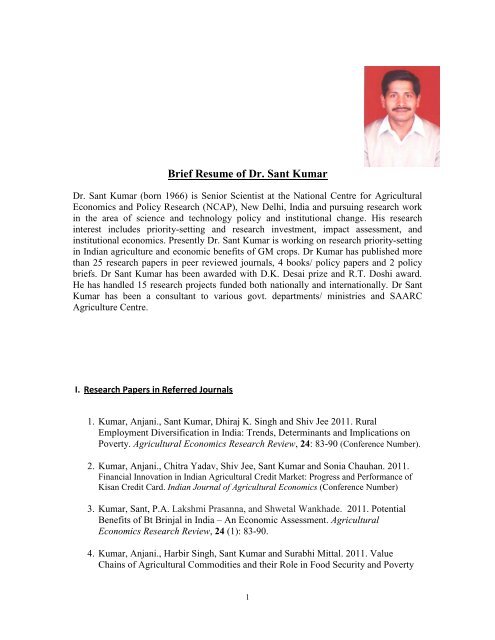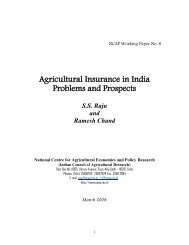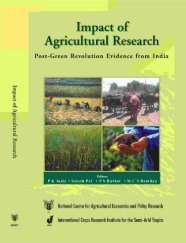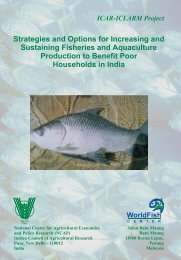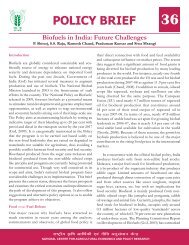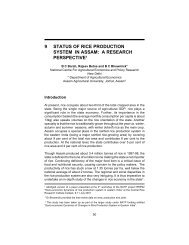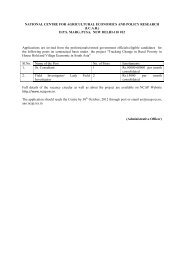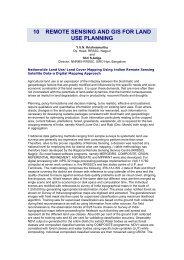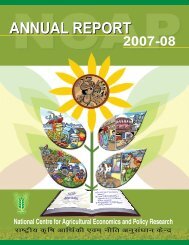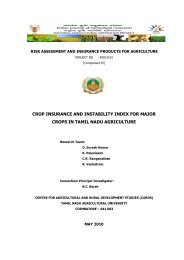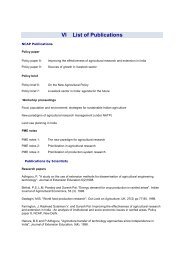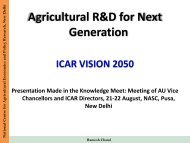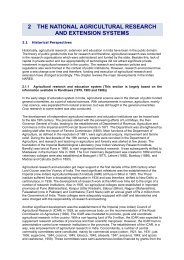S. K. Pandey - NCAP
S. K. Pandey - NCAP
S. K. Pandey - NCAP
You also want an ePaper? Increase the reach of your titles
YUMPU automatically turns print PDFs into web optimized ePapers that Google loves.
Brief Resume of Dr. Sant KumarDr. Sant Kumar (born 1966) is Senior Scientist at the National Centre for AgriculturalEconomics and Policy Research (<strong>NCAP</strong>), New Delhi, India and pursuing research workin the area of science and technology policy and institutional change. His researchinterest includes priority-setting and research investment, impact assessment, andinstitutional economics. Presently Dr. Sant Kumar is working on research priority-settingin Indian agriculture and economic benefits of GM crops. Dr Kumar has published morethan 25 research papers in peer reviewed journals, 4 books/ policy papers and 2 policybriefs. Dr Sant Kumar has been awarded with D.K. Desai prize and R.T. Doshi award.He has handled 15 research projects funded both nationally and internationally. Dr SantKumar has been a consultant to various govt. departments/ ministries and SAARCAgriculture Centre.I. Research Papers in Referred Journals1. Kumar, Anjani., Sant Kumar, Dhiraj K. Singh and Shiv Jee 2011. RuralEmployment Diversification in India: Trends, Determinants and Implications onPoverty. Agricultural Economics Research Review, 24: 83-90 (Conference Number).2. Kumar, Anjani., Chitra Yadav, Shiv Jee, Sant Kumar and Sonia Chauhan. 2011.Financial Innovation in Indian Agricultural Credit Market: Progress and Performance ofKisan Credit Card. Indian Journal of Agricultural Economics (Conference Number)3. Kumar, Sant, P.A. Lakshmi Prasanna, and Shwetal Wankhade. 2011. PotentialBenefits of Bt Brinjal in India – An Economic Assessment. AgriculturalEconomics Research Review, 24 (1): 83-90.4. Kumar, Anjani., Harbir Singh, Sant Kumar and Surabhi Mittal. 2011. ValueChains of Agricultural Commodities and their Role in Food Security and Poverty1
Alleviation – A Synthesis. Agricultural Economics Research Review, 24 (1): 169-181.5. Kumar, Sant. 2010. Networking of Agricultural Economists and Policy Research.Agricultural Economics Research Review, 23 (1): 191-193.6. Prasanna, P. A. Lakshmi., Sant Kumar and Aruna Singh. 2009. Rice Production inIndia — Implications of Land Inequity and Market Imperfections. AgriculturalEconomics Research Review, 22 (Conference Number), pp 431-4427. Kumar, Sant., and Rashi Mittal. 2009. Role of Agricultural R&D Policy inManaging Agrarian Crisis in India. Agricultural Economics Research Review, 22(1): 121-128.8. Kumar, Sant. 2009. Potentialities to Raise Wheat Output: Identification andPrioritization of Constraints. Indian Journal of Agricultural Sciences, 79 (1):53-57.9. Kumar, Sant. 2007. Exploring Possibility to Bring Second Green Revolution inIndia: The Case of Wheat. Agricultural Situation in India, 64 (5):71-74.10. Mruthyunjaya, Sant Kumar, M.T. Rajashekhrappa, L.M. <strong>Pandey</strong>, S. V. RamanaRao, and Prem Narayan. 2005. Efficiency in Indian Edible Oilseed Sector:Analysis and Implications. Agricultural Economics Research Review, 18(2):153:166.11. Mruthyunjaya, Sant Kumar, and Shalendra. 2005. Rural Development ThroughAgriculture-based interventions. Statistics and Applications, 3 (172): 15-22.12. <strong>Pandey</strong>, L.M., Sant Kumar, and Mruthyunjaya. 2005. Instability, Supply Responseand Insurance in Oilseeds Production in India. Agricultural Economics ResearchReview, 18 (Conference Number):103:114.13. Kumar, Sant, P. K. Joshi and Suresh Pal. 2003. Growing Vegetables: Role ofResearch, Economic and Political Weekly, Vol. XXXVIII (8). February 22-28,14. Singh, Harbir and Sant Kumar. 2001. Transition in crop-livestock systems in India:Some hypotheses, Journal of Rural Development, 34 (1): 67-77.15. Birthal, Pratap S., O. P. Sharma, and Sant Kumar. 2000. Economics of integratedpest management: Evidences and issues. Indian Journal of AgriculturalEconomics, 55(4): 644-659.16. Birthal, Pratap S., O. P. Sharma, Sant Kumar, A. Dhandapani. 2000. Pesticide usein rainfed cotton: Intensity, frequency and determinants, Agricultural EconomicsResearch Review, 13(2): 107-122.17. <strong>Pandey</strong>, R K., and Sant Kumar. 1999. Economic analysis of demand patterns forperishable products. Indian Journal of Agricultural Marketing, 13(2): 1-5.2
18. Bhalerao, M.M., and Sant Kumar. 1992. Commercial bank finance to agriculture inIndia- An analysis. Southern Economist, October, pp. 17-21.19. Bhalerao, M.M., and Sant Kumar. 1992. NABARD finance in India- An analysis.The Mysore Economic Review, October pp. 12-14.20. Jha, Dayanatha., Sant Kumar and Laxmi Joshi. 2006. Resources for HorticulturalResearch in India, The Horticultural Society of India, IARI, New Delhi.21. Mruthyunjaya, Sant Kumar and Shalendra. 2006. Impact of Vegetable Research onProduction, Consumption, Income and Employment, The Horticultural Society ofIndia, IARI, New Delhi22. Kumar, Sant and Sonia Chauhan. 2007. Production performance and Total factorProductivity Growth of Oilseeds in India. In: Changing Global Vegetable oilsScenario: Issues and Challenges before India, Indian Society of Oilseeds Research,DOR, Hyderabad (India), p. 239-246.II. International Exposure:Visited Michigan State University, East Lansing, USA and attended foreign trainingin the area of ‘Impact Assessment of Agricultural Research and Development’ during4-24 August 2011, in the Department of Agricultural, Food and Resource Economics,Institute of International Agriculture, Michigan State University, East Lansing, USA.Visited Dhaka, Bangladesh for presenting a Country paper on ‘NationalAgricultural Research System Management in India’ in a consultation meetingorganized by SAARC Agriculture Centre (SAC), Dhaka, during 22-23 December2010.Visited Cornell University, Ithaca, New York, USA and attended a program on'Food & Agri Business Management Program: Accessing Global Markets' jointlyorganized by Cornell University, Ithaca, New York, and Sathguru ManagementConsultants, Hyderabad (India), 2-9 May 2007. Visited Japan to attend a training program under ‘Japan South West Asia YouthFriendship Program in Agriculture’ organized by Japan International CooperationAgency (JICA), Japan, 20 Sept. to 16 Oct 2001.III.Awards1. 'R.T. Doshi Award' (2005) by the Agricultural Economics Research Association(India) for best research article on Efficiency in edible oilseed sector: Analysis andimplications, published in Agricultural Economics Research Review (AERR), 18(2): 153-166. (Coauthored)3
2. 'D.K. Desai Award' (2000) by the Indian Society of Agricultural Economics(Mumbai) for best research article on Economics of Integrated Pest Management:Evidences and Issues, Indian Journal of Agricultural Economics (IJAE), 55 (4):644-659, October- December. (Coauthored)IV. Research Briefs1. Scientific Manpower Resources of ICAR: Attributes and Allocation (2004)Dayanatha Jha, Sant Kumar, Praveen Kumar and Laxmi Joshi2. Overview of Financial Resources of ICAR (2004)Dayanatha Jha, Sant Kumar, Praveen Kumar and Laxmi Joshi3. Scientific Manpower Resources of SAUs: Attributes and Allocation (2004)Dayanatha Jha, Sant Kumar, Laxmi Joshi and Praveen Kumar4. Overview of Financial Resources of SAUs (2004)Dayanatha Jha, Sant Kumar, Laxmi Joshi and Praveen KumarV.Book chapters1. Kumar, Sant., Suresh Pal and Rashi Mittal (2011) Role of Agricultural R&DPolicy in Managing Agrarian Crisis, In: Agrarian Distress in India: Problems andRemedies. Eds. Barah, B.C. and Smita Sirohi, Concept Publishing Company, Pvt.Ltd. New Delhi.2. Kumar, Sant and Sonia Chauhan. 2007. Production performance and Total factorProductivity Growth of Oilseeds in India. In: Changing Global Vegetable oilsScenario: Issues and Challenges before India, Indian Society of OilseedsResearch, DOR, Hyderabad (India), pp. 239-2463. Jha, Dayanatha, Sant Kumar and Laxmi Joshi. 2006. Resources for HorticulturalResearch in India. Crop Improvement and Production Technology ofHorticultural Crops. Eds: Chadha, K.L., B.S. Ahloowalia, K.V. Prasad and S KSingh. The Horticultural Society of India, Vol II.4. Mruthyunjaya, Sant Kumar and Shalendra. 2006. Impact of vegetables researchon production consumption income and employment in India. Crop Improvementand Production Technology of Horticultural Crops. Eds: Chadha, K.L., B.S.Ahloowalia, K.V. Prasad and S K Singh. The Horticultural Society of India, VolII.5. Birthal, P.S., O.P. Sharma and Sant Kumar. 2005. Economic Evaluation ofIntegrated Pest Management in Cotton. In Impact of Agricultural Research: PostGreen Revolution Evidence from India (Eds: P.K. Joshi, Suresh Pal, P.S. Birthaland M.C.S. Bantilan). Jointly published by <strong>NCAP</strong>, New Delhi and ICRISAT,Patancheru, pp. 261-279.4
S. No. Topic Duration Venue1 Agricultural policy analysis 7-11 Dec 2009 CSD, New Delhi2 Orientation to field staff for filling upsurvey schedule for Bt brinjal study3 Impact assessment of improvedagricultural technologies4 Sensitization on research priorityassessment5 Research prioritization in irrigated agroecosystem6 Agricultural research prioritization fordifferent agro eco-regions of India28-29 Aug 2009 <strong>NCAP</strong>, New Delhi26-28 Aug 2009 <strong>NCAP</strong>, New Delhi21-22 June 2000 UAS, Bangalore30-31 Mar 1999 CSSRI, Karnal1-6 Feb 1999 <strong>NCAP</strong>, New DelhiVIII. Workshops / Seminars OrganizedS. No. Topic Duration Venue1 Methodological issues in assessing impactof watershed programs6 August 2010 NASC Complex,New Delhi2 Linking farmers and agro-based SMEs tomarkets17-18 March2009NASC Complex,New Delhi3 Methodological workshop on impactassessment of improved agriculturaltechnology26-28 Aug 2009 <strong>NCAP</strong>, New Delhi4 Impact of vegetable research in India 1-2 March 2002 IIVR, Varanasi5 Impact of agricultural research 10-11 Feb 2000 ICRISAT,Hyderabad6 Agriculture-industry interface in thechanging environment16-17 Sept 1997 <strong>NCAP</strong>, New Delhi6
IX.Project Handled:S. Project tile Position Funding Amount InstitutionsDurationNo.agency (Rs lakh) involved1 Ex-ante Socioeconomic Study of Bt brinjal PI MoE&F,Govt. of India13.79 <strong>NCAP</strong> andIASDS, LucknowJuly 2009 toAug 20102 Visioning, Policy Analysis and Gender (V-PAGe) Co-PI NAIP 1071.0 <strong>NCAP</strong>, IASRI,NAARM, DRWA,June 2007 toMar 2012Yes Bank, AgriWatchand 15 PME Cells3 Research Resource Allocation in Agriculture Co-PI ICAR 100 <strong>NCAP</strong> July 2001 toMar 20054 Institutionalization of Priority Setting, Monitoringand Evaluation in the NARSCo-PI NATP 136.45 <strong>NCAP</strong>, IASRI,NAARM and 25 PMEApril 1998 toMarch 2005Cells5 Improving Technical Efficiency to Counter Import Co-PI NATP 10.975 <strong>NCAP</strong> and DOR, Hyd April 2002 toThreat of Edible Oils in India6 Increasing Production and Productivity of LifeSupport Crop Species and Allied Enterprises inTribal, Backward and Hilly AreasCo-PI NATP/ ICAR 78.0 <strong>NCAP</strong>, IASRI, CIAE,CISH, CIFRI, IGAU,Raipur, AAU, JorhatMarch 2005Jan 2000 toMar 20057 Research Resource Allocation in Agriculture: TheCase of WheatPI Institute <strong>NCAP</strong> April 2006 toMar 20088 Impact of vegetable research in India PI Institute <strong>NCAP</strong> Jan 2003 toDec 200410 Impact of Integrated Pest Management in India Co-PI Institute <strong>NCAP</strong> July 1998 toDec 201011 Prioritizing Production Constraints in Cotton BasedProduction System: The Case of MaharashtraPI Institute <strong>NCAP</strong> Jan to Dec199912 Agriculture in Coastal Eco-System PI Institute <strong>NCAP</strong> June 1998 toMarch 19997


